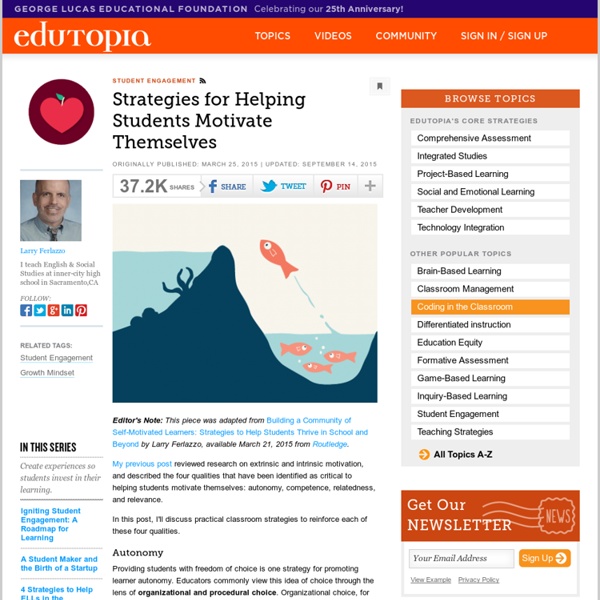Home of free rubric tools: RCampus
Welcome to iRubric iRubric is a comprehensive rubric development, assessment, and sharing tool. Designed from the ground up, iRubric supports a variety of applications in an easy-to-use package. Best of all, iRubric is free to individual faculty and students. iRubric School-Edition empowers schools with an easy-to-use system for monitoring student learning outcomes and aligning with standards.
COMICS IN THE CLASSROOM: How one Wissahickon teacher uses comic books to connect with his students - Ambler Gazette
By Dutch Godshalkdgodshalk@21st-centurymedia.com@DutchGodshalk on Twitter Wissahickon High School social studies teacher Tim Smyth uses comic books in his class lessons. BOB RAINES -- DIGITAL FIRST MEDIA LOWER GWYNEDD >> A few years ago, Wissahickon High School social studies teacher Tim Smyth, a by-the-book AP instructor who had earned himself a reputation among students for being “very challenging,” did something unexpected.
Error Correction
The danger of over-correcting is that students will lose motivation and you may even destroy the flow of the class or the activity by butting in and correcting every single mistake. The other extreme is to let the conversation flow and not to correct any mistakes. There are times when this is appropriate but most students do want to have some of their mistakes corrected as it gives them a basis for improvement.
Computer Literacy Self-Assessment : Saint Anselm College
A critical factor in online learning success is computer literacy. Students should possess basic computer skills and be able to communicate effectively using various technology tools. This Self-Assessment Guide is designed to help you determine if you will need additional technology training or practice to meet the computer literacy requirements of our blended program.
Kids Speak Out on Student Engagement
A while back, I was asked, "What engages students?" Sure, I could respond, sharing anecdotes about what I believed to be engaging, but I thought it would be so much better to lob that question to my own eighth graders. The responses I received from all 220 of them seemed to fall under 10 categories, representing reoccuring themes that appeared again and again. So, from the mouths of babes, here are my students' answers to the question: "What engages students?"
Bringing closure to a lesson – On the same page
Bringing closure to a lesson connects what has just been learnt with both previous and future learning experiences, encourages student reflection on their work and progress, and provides invaluable information for formative assessment. The amount of time spent on lesson lead-ins and the variety of activities and strategies used to this end has often little to do with the time devoted to wrapping up a lesson, missing a meaningful learning opportunity altogether – and one that is notably crucial. At its very simplest, asking the students a variety of questions on different aspects of the lesson or project, having them predict what the following lesson might be about, or just eliciting one-word responses from them, are all quick effective ways of closing a lesson. 1. On a slip of paper students write down something they have learnt, or a short personal response to some reading or speaking activity.
Coda - One-Window Web Development for Mac OS X
Good question. Coda is everything you need to hand-code a website, in one beautiful app. While the pitch is simple, building Coda was anything but. How do you elegantly wrap everything together? Well, we did it. And today, Coda has grown to be a critical tool for legions of web developers around the world.
Engagement Vs. Compliance
The “Rule of Two Feet” I recently attended a conference that asked attendees to follow the “rule of two feet”. Throughout the conference day, if you found yourself in a session that didn’t apply or interest you, it was fine to pick up and move to another session. The presenter would not be offended, but would realize that the session was not a good match for that particular person.
25 ideas for using audio scripts in the ELT classroom
Philip Haines is the Senior Consultant for Oxford University Press, Mexico. As well as being a teacher and teacher trainer, he is also the co-author of several series, many of which are published by OUP. Today he joins us to provide 25 engaging and useful classroom activities for language learners using audio scripts. Many ELT student books come with audio scripts at the back. However, these are sometimes not exploited to the full. Here are 25 ideas for how to make better use of this resource.
Awaken the Learner, Tips
Awaken the Learner To effectively prepare learners for success, teachers can emphasize cognitive skills in addition to content in their classrooms. Teaching knowledge has always been an essential component of the American school system, but recent instructional standards have also highlighted the importance of teaching cognitive skills. Cognitive skills, such as generating conclusions, problem solving, experimenting, and decision making, are thinking processes that promote a deeper comprehension of complex ideas.
First Lesson: Student generated ID card Swap
This was a lesson I did with a class of elementary level learners yesterday. My class were quite young, hence some of the content below, but it is quite easily adaptable to other ages and levels. It doesn’t need any preparation, though the students will need pens / pencils and paper. I started by eliciting “an ID card” and then by eliciting the kind of information you typically find on an ID card. The class came up with: name, age, date of birth, Card expiry date, and address. I then said we were going to make our own ID card – what other information could we put on it?



